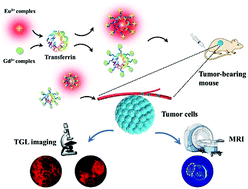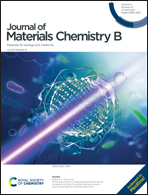Bioconjugates of versatile β-diketonate–lanthanide complexes as probes for time-gated luminescence and magnetic resonance imaging of cancer cells in vitro and in vivo†
Abstract
Magnetic resonance imaging (MRI) and optical imaging (OI) are attractive for constructing bimodal probes due to their complementary imaging characteristics. The combination of these two techniques could be a useful tool to simultaneously obtain both anatomical and molecular information as well as to significantly improve the accuracy of detection. In this study, we found that β-diketonate–lanthanide complexes, BHHBCB–Ln3+, could covalently bind to proteins to exhibit long-lived and intense luminescence (Ln3+ = Eu3+, τ = 0.52 ms, Φ = 0.40) and remarkably high relaxivity (Ln3+ = Gd3+, r1 = 35.67 mM−1 s−1, r2 = 43.25 mM−1 s−1) with excellent water solubility, stability and biocompatibility. Hence, we conjugated BHHBCB–Ln3+ with a tumor-targetable biomacromolecule, transferrin (Tf), to construct the probes, Tf–BHHBCB–Ln3+, for time-gated luminescence (TGL, Ln3+ = Eu3+) and MR (Ln3+ = Gd3+) imaging of cancerous cells in vitro and in vivo. As expected, the as-prepared probes showed high specificity to bind with the transferrin receptor-overexpressed cancerous cells, to enable the probe molecules to be accumulated in these cells. Using Tf–BHHBCB–Ln3+ as probes, the cultured cancerous cells and the tumors in tumor-bearing mice have been clearly visualized by background-free TGL and in vivo MR imaging. The research outcomes suggested the potential of β-diketonate–lanthanide complexes for use in constructing bimodal TGL/MR imaging bioprobes.



 Please wait while we load your content...
Please wait while we load your content...